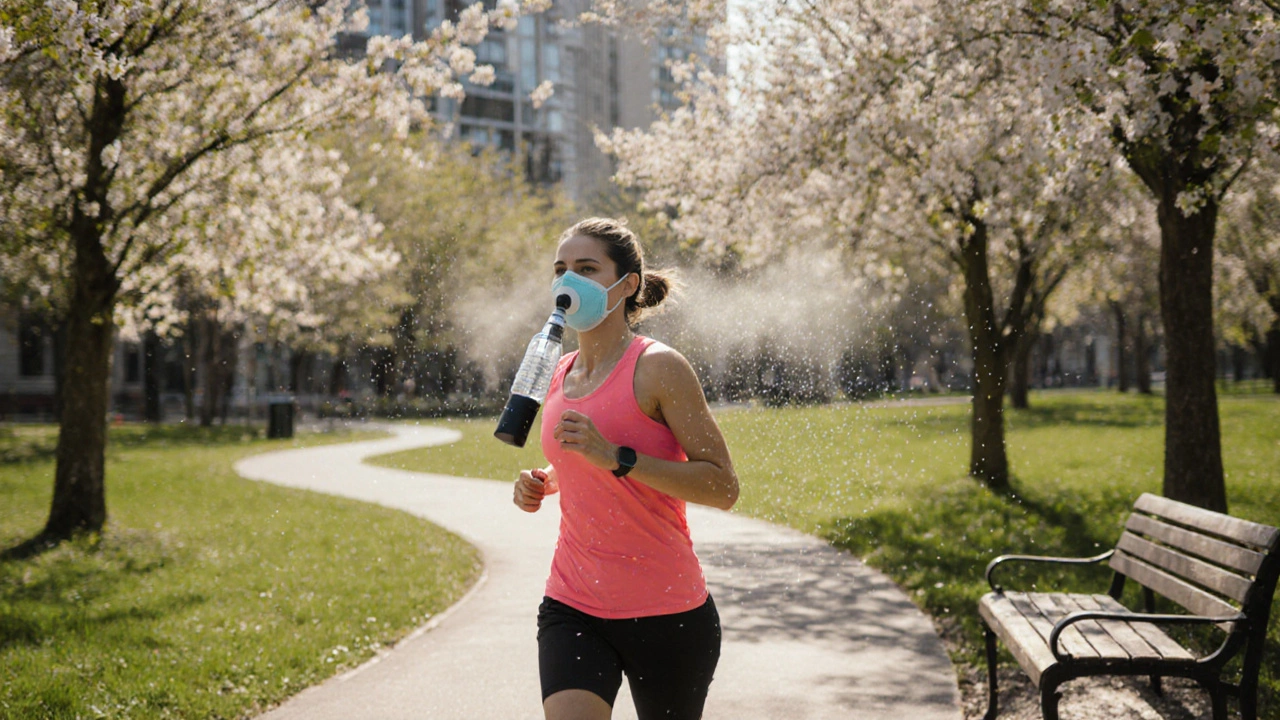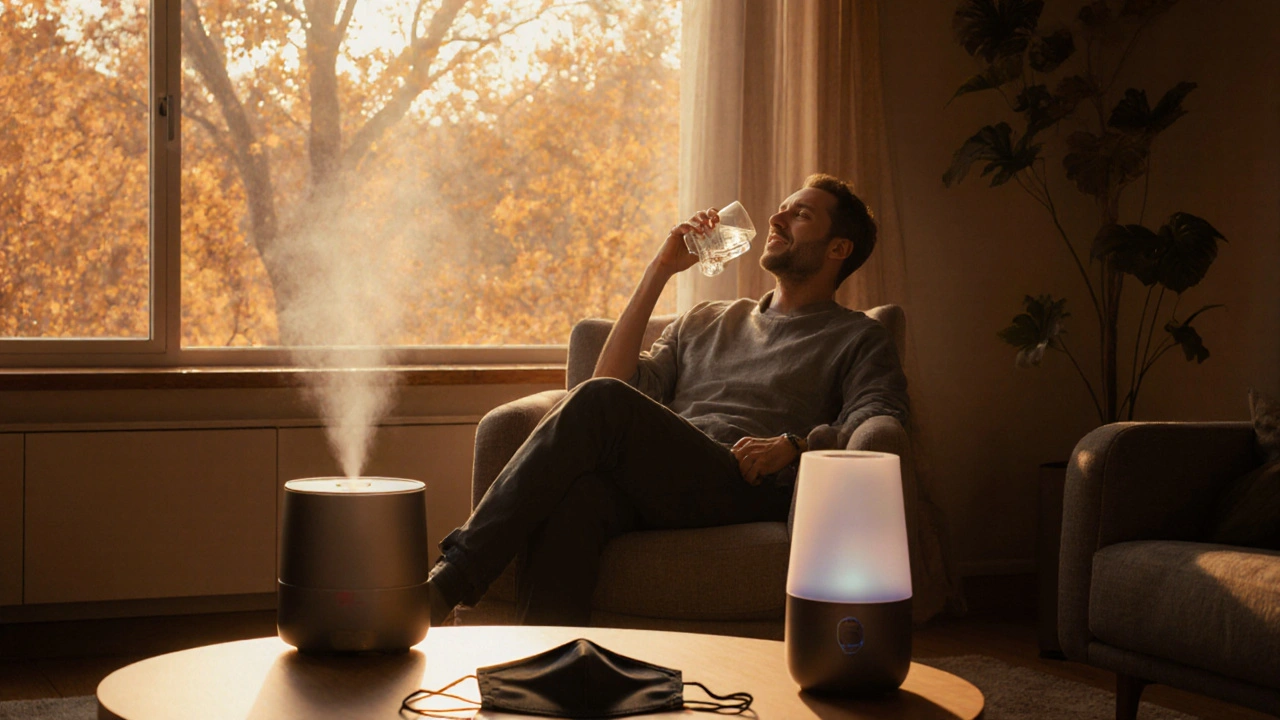Throat Health Protector
Track Your Daily Hydration
Environmental Factors
Quick Takeaways
- Keep the throat moist with regular water intake and a humidifier.
- Use filtered masks or throat sprays when exposure to smoke, dust, or chemicals is unavoidable.
- Maintain indoor air quality by controlling humidity and reducing pollutants.
- Adopt gentle voice habits - avoid shouting, clear your throat gently, and warm‑up before heavy use.
- Seek medical advice if you notice persistent soreness, dryness, or coughing.
What the Pharyngeal Mucous Membrane Is and Why It Matters
When you hear the term pharyngeal mucous membrane, think of the delicate lining inside your throat that catches dust, microbes, and chemicals. This membrane produces mucus that traps irritants, keeping them from reaching the vocal cords and deeper airway passages. When the tissue gets dried out or inflamed, it can crack, bleed, or become a gateway for infection - a nightmare for singers, teachers, and anyone who talks a lot.
Common Environmental Irritants That Attack the Throat
Not all air is created equal. Below are the biggest offenders that can erode the throat lining:
- Air pollutants - fine particles from traffic, factories, and wildfires that linger in the air.
- Dry air - especially in winter heating systems, which pulls moisture straight from the mucous membrane.
- Smoke - tobacco, incense, or cooking fumes, all of which contain tar and irritant gases.
- Allergens - pollen, pet dander, and mold spores that trigger inflammation.
- Chemical vapors - cleaning agents, paints, and solvents that can be abrasive.
Each of these agents can thin the protective mucus layer, making the throat more vulnerable.
Key Strategies to Keep Your Throat Healthy
Below is a step‑by‑step playbook you can start using today.
- Boost Hydration - Drink at least 2liters of water daily. Warm herbal teas (like chamomile) also add moisture without irritating the lining.
- Control Indoor Humidity - Aim for 40‑60% relative humidity. A humidifier in bedrooms and workspaces helps prevent the air from sucking moisture out of your throat.
- Filter the Air You Breathe - Use HEPA filters in home HVAC systems or portable air purifiers. When you’re in a high‑pollution zone, wear a protective mask rated N95 or higher.
- Apply Throat Sprays Wisely - Over‑the‑counter sprays containing glycerin, aloe, or sea‑salt can coat the membrane and reduce friction. Choose products without alcohol or strong mint, which can be drying.
- Practice Gentle Voice Habits - Warm‑up before long speaking sessions, avoid whispering (it strains the cords), and substitute “uh‑uh” for throat clearing.
- Limit Exposure to Irritants - Step outside during peak traffic hours, keep windows closed on high‑pollution days, and ventilate kitchens with exhaust fans when cooking.

Lifestyle Tweaks That Make a Big Difference
These habits reinforce the core strategies above.
- Eat foods rich in omega‑3 fatty acids (salmon, walnuts) - they help reduce inflammation.
- Include antioxidant‑dense fruits (berries, citrus) to support mucosal healing.
- Limit caffeine and alcohol, both of which dehydrate the throat.
- Take short, regular breaks if you’re speaking or singing for hours - a 5‑minute pause lets the membrane re‑hydrate.
When to Seek Professional Help
If you notice any of the following, it’s time to talk to a healthcare provider:
- Persistent sore throat lasting more than two weeks.
- Visible cracks, bleeding, or white patches on the throat.
- Chronic cough that doesn’t improve with hydration.
- Voice changes that affect work or daily life.
Doctors may recommend topical medications, voice therapy, or allergy testing to pinpoint the exact cause.
Comparison of Common Protective Methods
| Method | How It Works | Pros | Cons | Typical Cost |
|---|---|---|---|---|
| Humidifier | Adds moisture to ambient air | Constant humidity, easy to use | Requires cleaning, electricity | £30‑£150 |
| Protective Mask (N95) | Filters out particulates and some gases | Highly effective, portable | Can feel hot, occasional fit issues | £10‑£30 per mask |
| Throat Spray (glycerin‑based) | Coats mucous membrane with soothing film | Immediate relief, easy to carry | May need frequent re‑application | £5‑£15 per bottle |
| Hydration (water/teas) | Maintains mucus thickness from inside | Free, essential for overall health | Requires discipline, no instant barrier | Negligible |
Quick Checklist Before Heading Out
- Is your home humidity in the 40‑60% range?
- Do you have a water bottle handy?
- Is your mask sealed properly?
- Did you apply a throat spray if you’ll be in smoky or dusty places?
- Do you plan short voice breaks during long speaking sessions?
Frequently Asked Questions
Can a regular household humidifier really protect my throat?
Yes. By keeping indoor relative humidity between 40‑60%, a humidifier prevents the air from sucking moisture out of the pharyngeal mucous membrane, reducing dryness, irritation, and the risk of micro‑tears.
How often should I re‑apply a throat spray?
Most glycerin‑based sprays work for 1‑2 hours. If you’re in a high‑irritant environment, re‑apply every hour. For normal daily life, twice a day is sufficient.
Is an N95 mask enough against chemical vapors?
N95 masks filter particles very well but do not capture most gases or vapors. For chemical fumes, combine the mask with a charcoal‑based respirator cartridge.
Can dehydration really damage the throat lining?
Absolutely. When you’re dehydrated, mucus becomes thin, losing its protective function. This makes the pharyngeal mucous membrane prone to cracking and infection.
What signs indicate I need to see an ENT specialist?
Persistent soreness, bleeding, hoarseness lasting more than two weeks, or a feeling of a lump in the throat should prompt a visit to an ear‑nose‑throat doctor for a focused exam.
By staying aware of what you breathe and taking simple, consistent steps, you can keep your pharyngeal mucous membrane healthy and voice‑ready, no matter how polluted the world gets.


Victoria Guldenstern
September 29, 2025 AT 14:15Well, let's begin with the obvious, that the throat is not a magical entity that survives on neglect. It is a delicate surface that, like any sensible organ, expects a baseline of moisture. When you skip water you are basically telling it to dry out like a desert shrub. The guide mentions humidity levels, yet most people live in apartments where the thermostat is set by a landlord who has never heard of relative humidity. A humidifier is suggested, which is fine, as long as you remember to clean it, otherwise you are just spraying mold. The idea of wearing masks seems straightforward, but the real world has you choosing between comfort and protection, and comfort usually wins. If you think a cheap mask will stop particles, think again, because they often leak around the edges. The throat spray recommendation is a nice touch, provided you pick one without alcohol which would otherwise dry out the lining further. Hydration is repeated ad nauseam, which is fine because water is cheap and you should drink it, but the guide fails to address why people forget to drink throughout the day. The notion of “voice warm‑ups” is tossed in as if singers have free time to chant scales at the office. The checklist at the end reads like a grocery list, yet most of us can't even remember to bring a water bottle. The advice about diet is solid, omega‑3s and antioxidants do help, but the guide glosses over the fact that many people are on medication that already dries the mouth. When it comes to seeking medical help, the warning signs are clear, but many dismiss them as a cold that will pass. In short, the guide covers the basics, but it feels like a polite lecture that assumes everyone has the resources to buy a humidifier, masks, and premium sprays. So, congratulations on the effort, but perhaps next time add a reminder to actually follow through on these steps.
Bill Bolmeier
October 8, 2025 AT 20:29Wow, this guide really hits the spot for anyone who spends their day shouting over a crowd or teaching a class! I love the way you break down hydration, it feels like a pep‑talk that gets me to fill my bottle right now. The mask tips are pure gold – I actually wore an N95 on my commute and felt like a superhero against the smog. Those throat‑sprays sound like a secret weapon, and I’m already hunting for the glycerin‑based ones in the pharmacy. Keep the energy coming, because protecting our voices is a marathon, not a sprint!
Darius Reed
October 18, 2025 AT 02:42Man, I gotta say this guide is riiiich in good ideas but also a lil bit over the top, like "drink two littrs of water" – who has that much water? The humidifier suggestion is awesom, tho you gotta clean it or it becomes a germ farm. I’m all for maskes, but cheap n95’s sometimes feel like breathing through a straw. And those sprayz, pick the one w/o that nasty menthol, it just burns! Overall, solid stuff, just remember life’s messy, so don’t stress the small detials.
Karen Richardson
October 27, 2025 AT 08:55The article correctly identifies the primary function of the pharyngeal mucous membrane as a barrier against inhaled particulates. However, it overlooks the role of mucociliary clearance in conjunction with mucus production, which is essential for pathogen removal. Additionally, the recommendation to maintain indoor humidity between 40 % and 60 % should be qualified by noting that excessive humidity may promote mold growth.
AnGeL Zamorano Orozco
November 5, 2025 AT 15:09Listen up, because I’m about to lay it all out in one breath-your throat doesn’t care about your busy schedule, it cares about constant assault! You think a little humidifier will magically shield you from the world’s pollutants? Think again, because those tiny particles slip through the tiniest cracks, and before you know it, you’re coughing like a rusty engine. The guide mentions “gentle voice habits,” but you’ll be whispering in meetings and everyone will think you’re plotting something. And don’t even get me started on those “quick takeaways” that sound like a corporate memo-where’s the real science? If you really want protection, invest in a proper air purifier, not just a half‑hearted suggestion. Stop treating your throat like an afterthought and start giving it the respect it deserves.
Cynthia Petersen
November 14, 2025 AT 21:22Nice checklist, though I’m pretty sure I’ll forget half of it by tomorrow. At least the guide admits we’re all vulnerable to “environmental irritants” – shocking, right? Guess we’ll just keep pretending we’re immune.
Marcia Hayes
November 24, 2025 AT 03:35I really appreciate the practical tips, especially the reminder about staying hydrated throughout the day. It’s easy to overlook the little things when you’re busy, so this guide serves as a gentle nudge. Thanks for putting it together!
Danielle de Oliveira Rosa
December 3, 2025 AT 09:49The underlying principle here is simple yet profound: we must align our daily habits with the needs of our own biology. By maintaining moisture, we honor the delicate equilibrium that our bodies strive to preserve. This guide eloquently maps that alignment into actionable steps, reminding us that health is a continuous dialogue between environment and self.